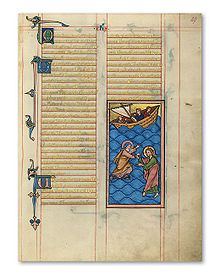Jagged style
The jagged style , also known as the "jagged style", is a transition style between Romanesque and Gothic in book , wall and glass painting .
The characteristic feature of the zigzag style is the zigzag-shaped, sharply broken line play of folds and contours while largely retaining the traditional Romanesque forms. The late phase shows a playful linearism . The spikes should bring movement and emotionality into the pictures.
It developed from Byzantine and West German roots in the first half of the 13th century. Preliminary stages can be found in Thuringia , on the Middle Rhine and in the Regensburg book illumination . For example, this art form is already reflected in the illustrations of the Landgrave Psalter (1211–1213).
The example of the altarpiece with the mercy seat in Soest (today in Berlin ) shows the masterful implementation of a Cologne master. The Zackenstil reached its full development in Austria after the middle of the century. Significant works of this style can be found in Vienna (e.g. Wimpassinger Kreuz in the Minoritenkirche ), in Lower Austria (e.g. fresco around 1280 in the Dominican Church in Krems / Coronation of Mary with the donor couple Gozzo von Krems ) and especially in Carinthia-Styria Room (e.g. bishop's chapel in Gurk , 1264). In Poland, for example, the keystones in the Dominican Church in Krakow have corresponding characteristics. A remarkable example has been preserved in the form of the stained glass from the Minorite Church in Bruck an der Mur (today Joanneum ). A blessing Christ is depicted and is dated around 1280.
Influenced by the emerging Gothic architecture in France, the Zackenstil developed in German book illumination. Typical examples of this are the Brandenburg Evangelistary , the Elisabeth psaltery in Cividale del Friuli and the Mainz Gospel Book from 1250.
The splendid initials of a manuscript of the Moralia in Job of Gregory the Great are described and illustrated in the short inventory of the illuminated manuscripts of the Augustinian Canons of Herzogenburg.
Examples
Cologne: Altarpiece with mercy seat , 1260
Graz: Leechkirche Madonna and Child in the tympanum , ca.1280
Web links
- Sabine Koch, The Zackenstil in Monumental Painting on the Lower Rhine , Inaugural Dissertation Ruprecht-Karls-Universität Heidelberg , 2013
Individual evidence
- ^ Austria-Forum , Wimpassinger Kreuz , accessed on January 16, 2018
- ^ Daniel Hess: Baroque late Romanesque or Byzantine Gothic? The Jagged Style in the Visual Arts from 1250 to 1290
- ↑ Elisabeth Oberhaidacher-Herzig, in History of Fine Arts in Austria, Volume 2, Gothic, edited by Günter Brucher , No. 166, page 416, illustration panel on page 99, Prestel Verlag, 2000, ISBN 3-7913-2349-0
- ^ Hans Belting : Between Gothic and Byzantium. Thoughts on Saxon illumination in the 13th century. In: Zeitschrift für Kunstgeschichte 1978, pp. 217–282. - Renate Kroos: Sächsische Buchmalerei 1200–1250, a research report, ibid, pp. 283–316.
- ↑ Brief inventory of the illuminated manuscripts up to 1600 at www.univie.ac.at



